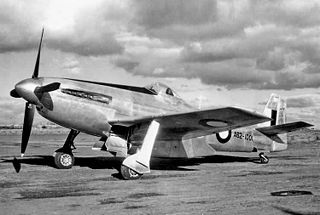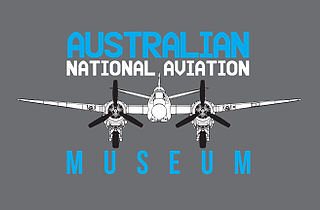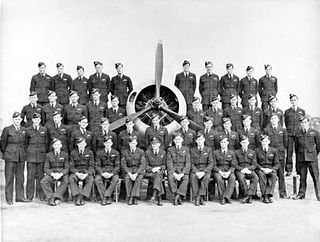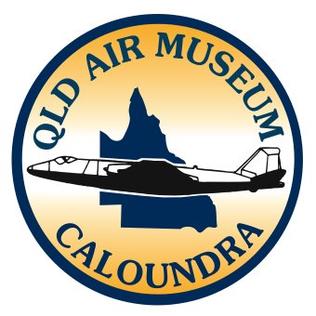
The CAC Boomerang is a fighter aircraft designed and manufactured in Australia by the Commonwealth Aircraft Corporation between 1942 and 1945. Approved for production shortly following the Empire of Japan's entry into the Second World War, the Boomerang was rapidly designed as to meet the urgent demands for fighter aircraft to equip the Royal Australian Air Force (RAAF). It was the first combat aircraft designed and constructed in Australia.

The Lockheed Hudson is a light bomber and coastal reconnaissance aircraft built by the American Lockheed Aircraft Corporation. It was initially put into service by the Royal Air Force shortly before the outbreak of the Second World War and primarily operated by it thereafter. The Hudson was a military conversion of the Model 14 Super Electra airliner, and was the first significant aircraft construction contract for Lockheed — the initial RAF order for 200 Hudsons far surpassed any previous order the company had received.

The North American Aviation NA-16 is the first trainer aircraft built by North American Aviation, and was the beginning of a line of closely related North American trainer aircraft that would eventually number more than 17,000 examples, notably the T-6 Texan family.

The CAC CA-15, was an Australian propeller-driven fighter aircraft designed by the Commonwealth Aircraft Corporation (CAC) during World War II. Due to protracted development, the project was not completed until after the war, and was cancelled after flight testing, when the advent of jet aircraft was imminent.

The CAC Wirraway is a training and general purpose military aircraft manufactured in Australia by the Commonwealth Aircraft Corporation (CAC) between 1939 and 1946. It was an Australian development of the North American NA-16 training aircraft. The Wirraway has been credited as being the foundation of Australian aircraft manufacturing.

The Commonwealth Aircraft Corporation (CAC) was an Australian aircraft manufacturer. The CAC was established in 1936, to provide Australia with the capability to produce military aircraft and engines.

The CAC CA-25 Winjeel is an Australian-designed and manufactured three-seat training aircraft. Entering service with the Royal Australian Air Force (RAAF) in 1955 as a basic to advanced trainer, it served in this role until 1975. Later, it was used in the Forward Air Control (FAC) role for target marking until 1994, after which it was retired from RAAF service.

Sir Lawrence James Wackett is widely regarded as "father of the Australian aircraft industry". He has been described as "one of the towering figures in the history of Australian aviation covering, as he did, virtually all aspects of activities: pilot, designer of airframes and engines, entrepreneur and manager". He was knighted for his services to aviation and was a winner of the Oswald Watt Gold Medal. He was also a keen angler and wrote two books on the subject.

The CA-11 Woomera was a production development of the earlier CA-4 Wackett Bomber prototype, and was an Australian torpedo and dive bomber aircraft that was designed and constructed by the Commonwealth Aircraft Corporation (CAC) during World War II. The order for the Woomera was cancelled before it became operational with the Royal Australian Air Force (RAAF).

The Moorabbin Air Museum is an aviation museum at Moorabbin Airport in Melbourne, Victoria, Australia. It was founded in 1962 as the Australian Aircraft Restoration Group, in an attempt to maintain a World War II-era Bristol Beaufighter aircraft. It has since become a museum, with a large aircraft collection. It was known as the Australian National Aviation Museum up until October 2021. As of 2021 it held nearly 60 aircraft and 25 engines.

RAAF Museum is the official museum of the Royal Australian Air Force located at RAAF Williams Point Cook, Victoria, Australia. The museum displays aircraft of significance to the RAAF from its inception as the Australian Flying Corps to the present.

The Commonwealth Aircraft CA-28 Ceres was a crop-duster aircraft manufactured in Australia by the Commonwealth Aircraft Corporation (CAC) between 1959 and 1963. The aircraft was a development of the Wirraway trainer of World War II.

The Yeoman Cropmaster was an Australian agricultural aircraft developed from the CAC Wackett trainer of World War II.

The KS-3 Cropmaster was an Australian agricultural aircraft developed from the CAC Wackett, an aircraft used for training purposes during World War II.

Air Vice Marshal Ellis Charles Wackett, CB, CBE was a senior commander in the Royal Australian Air Force (RAAF). Its chief engineer from 1935 to 1959, he served on the RAAF's controlling body, the Air Board, for a record seventeen years, and has been credited with infusing operations with new standards of airworthiness. Commencing his service career as a Royal Australian Navy cadet during World War I, Wackett transferred to the Air Force in 1923 while on an engineering course in Britain. He qualified as a pilot before completing his studies and returning to Australia, where he inaugurated parachute instruction within the RAAF and made the country's first freefall descent from a military aircraft in 1926. The following year, he led a three-month survey flight to Papua New Guinea.

No. 5 Service Flying Training School was a Royal Australian Air Force (RAAF) flight training unit that operated during World War II. It was one of eight Service Flying Training Schools established by the RAAF to provide intermediate and advanced flying instruction to new pilots as part of Australia's contribution to the Empire Air Training Scheme. No. 5 SFTS was formed at RAAF Station Uranquinty, New South Wales, in October 1941, and disbanded in February 1946. Its staff and equipment were employed to re-establish No. 1 Flying Training School, which transferred to RAAF Station Point Cook, Victoria, the following year. Care and Maintenance Unit Uranquinty was also formed from No. 5 SFTS's facilities, to look after surplus aircraft at the base prior to their disposal, and disbanded in December 1948.

No. 1 Basic Flying Training School was a flying training school of the Royal Australian Air Force (RAAF). Along with No. 1 Initial Flying Training School, it was formed in response to increased demand for aircrew during the Korean War and Malayan Emergency. No. 1 BFTS was established in December 1951 at RAAF Base Uranquinty, New South Wales, where it operated de Havilland Tiger Moths and CAC Wirraways. The school absorbed the activities of No. 1 IFTS in January 1955, as aircrew training requirements had eased following the end of the Korean War. No. 1 BFTS moved to RAAF Base Point Cook, Victoria, in May 1958, by which time it was exclusively flying CAC Winjeels. Its training program expanded in the mid-1960s owing to Australia's commitments in the Vietnam War. No. 1 BFTS was re-formed as No. 1 Flying Training School at Point Cook in January 1969.

No. 1 Aircraft Depot (No. 1 AD) was a maintenance unit of the Royal Australian Air Force (RAAF). Formed in July 1921 at RAAF Point Cook, Victoria, it relocated to the nearby RAAF Laverton in March 1926. As well as servicing aircraft and other equipment, in its early years the depot supported survey flights in Australia and the Pacific region. It was also responsible for training maintenance staff.

The Queensland Air Museum is a not-for-profit all-volunteer aviation museum located near the Caloundra Airport in Queensland, Australia. Its mission is to collect and preserve all aspects of aviation heritage with an emphasis on Australia and Queensland. The museum has the largest and most diverse collection of historic aircraft in Australia and it also has a large collection of aircraft engines, equipment, artefacts, photographs, uniforms and books.

The CAC Mustang is an Australian variant of the North American P-51 Mustang. It was built under license by Commonwealth Aircraft Corporation in the final stages of World War II, and though it was too late to see combat, it did participate in the Occupation of Japan after VJ-Day.





















